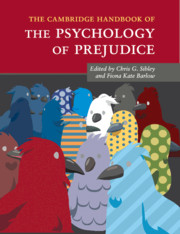Book contents
- Frontmatter
- Dedication
- Contents
- List of Figures
- List of Tables
- Notes on the Contributors
- Part I General Theoretical Perspectives
- Part II Prejudice in Specific Domains
- Part III Prejudice Reduction and Analysis in Applied Contexts
- 20 Recent Developments in Intergroup Contact Research: Affective Processes, Group Status, and Contact Valence
- 21 From Prejudice Reduction to Collective Action: Two Psychological Models of Social Change (and How to Reconcile Them)
- 22 Self-Regulation Strategies for Combatting Prejudice
- 23 Antecedents and Consequences of Evaluative Concerns Experienced During Intergroup Interaction: When and How Does Group Status Matter?
- 24 Stereotypicality Biases and the Criminal Justice System
- 25 Prejudice, Stigma, Bias, Discrimination, and Health
- 26 Development of Delegitimization and Animosity in the Context of Intractable Conflict
- 27 Interventions in Real-World Settings: Using Media to Overcome Prejudice and Promote Intergroup Reconciliation in Central Africa
- 28 Identification with All Humanity: The Antithesis of Prejudice, and More
- 29 It's All About Ignorance: Reflections from the Blue-eyed/Brown-eyed Exercise
- Index
- References
20 - Recent Developments in Intergroup Contact Research: Affective Processes, Group Status, and Contact Valence
from Part III - Prejudice Reduction and Analysis in Applied Contexts
Published online by Cambridge University Press: 17 November 2016
- Frontmatter
- Dedication
- Contents
- List of Figures
- List of Tables
- Notes on the Contributors
- Part I General Theoretical Perspectives
- Part II Prejudice in Specific Domains
- Part III Prejudice Reduction and Analysis in Applied Contexts
- 20 Recent Developments in Intergroup Contact Research: Affective Processes, Group Status, and Contact Valence
- 21 From Prejudice Reduction to Collective Action: Two Psychological Models of Social Change (and How to Reconcile Them)
- 22 Self-Regulation Strategies for Combatting Prejudice
- 23 Antecedents and Consequences of Evaluative Concerns Experienced During Intergroup Interaction: When and How Does Group Status Matter?
- 24 Stereotypicality Biases and the Criminal Justice System
- 25 Prejudice, Stigma, Bias, Discrimination, and Health
- 26 Development of Delegitimization and Animosity in the Context of Intractable Conflict
- 27 Interventions in Real-World Settings: Using Media to Overcome Prejudice and Promote Intergroup Reconciliation in Central Africa
- 28 Identification with All Humanity: The Antithesis of Prejudice, and More
- 29 It's All About Ignorance: Reflections from the Blue-eyed/Brown-eyed Exercise
- Index
- References
Summary
What are the consequences of bringing people from diverse groups together? Does it enhance trust and goodwill, or does it lead to mistrust and hostility? More than 60 years ago, social scientists offered initial evidence and theoretical perspectives regarding how contact between members of different groups can reduce intergroup hostility and promote positive intergroup attitudes (see Allport, 1954; Williams, 1947). Since then, Allport's (1954) formulation of intergroup contact theory has become one of the most enduring models in the history of social psychology (Brewer & Brown, 1998), as well as one of psychology's best strategies to improve intergroup relations (Pettigrew & Tropp, 2011).
This chapter provides an overview of recent theorizing and research on intergroup contact with a focus on three key developments in the literature. First, we highlight the special role of affective processes and friendship in improving intergroup attitudes while considering both direct and indirect forms of intergroup contact. We then review the differential effects and implications of contact among members of minority and majority groups and describe how contact effects reach far beyond shifts in intergroup attitudes. Finally, we discuss the effects of both positive and negative intergroup contact on attitudes and relations between groups.
Effects of Direct Contact
Research reveals the crucial roles that affective processes play in contact effects, both in terms of the kinds of contact that are most likely to improve intergroup attitudes and the kinds of positive outcomes we can expect from such contact (see Pettigrew & Tropp, 2011). With survey data from seven European samples, seminal work by Pettigrew (1997) showed that intergroup contact in the form of cross-group friendships was consistently and negatively associated with a range of prejudice measures, particularly those assessing feelings of sympathy and admiration toward the outgroup. In line with Pettigrew's (1997) findings, other studies indicate that cross-group friendships relate more strongly to reduced prejudice than more distant forms of contact (Herek & Capitanio, 1996), particularly when affective dimensions of prejudice such as feelings and emotions toward outgroup members are involved (Tropp & Pettigrew, 2005a).
Cross-group friendships. Empirical interest in the special role of cross-group friendships has expanded and corroborated these early findings through longitudinal, meta-analytic, and experimental research. Longitudinal surveys in several countries have shown that greater cross-group friendships predict more positive intergroup attitudes over time (Binder et al., 2009; Levin, van Laar, & Sidanius, 2003; Swart, Hewstone, Christ, & Voci, 2011).
- Type
- Chapter
- Information
- The Cambridge Handbook of the Psychology of Prejudice , pp. 463 - 480Publisher: Cambridge University PressPrint publication year: 2016
References
- 42
- Cited by



